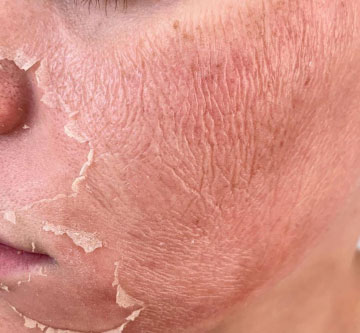Glycolic Peel
Glycolic acid is an alpha-hydroxy acid which provides a gentle, superficial peel of the skin and is an excellent introductory peel for all skin tones. In addition to its’ anti-inflammatory and antioxidant effects, glycolic peels provide excellent skin exfoliating results. Here at Regenesis, we utilize concentrations of 40 to 50% glycolic acid.
Frequent glycolic acid peels
Brighten skin tone
Improve the appearance of UV sun damaged skin
Rejuvenate a tired and dull complexion
Diminish the size of enlarged skin pores
Reduce the appearance of fine lines and wrinkles
Treat dark spots and post inflammatory hyperpigmentation
Stimulate collagen production within the skin
Increase the rate of cellular skin renewal
Smooth rough skin
Treat blemishes and mild acne
Promote the removal of blackheads, whiteheads, and pimples from the skin
Improve the appearance of acne scarred skin
Regulates the balance for those suffering from oily and acne prone skin
Treat mild rosacea, and melasma
Reduce the occurrence of ingrown hairs involving the face and body
Improve the appearance of white stretch marks
How it works
Glycolic acid peels remove dead skin cells and cellular debris. Because glycolic acid is a small molecule, it readily penetrates into the skin, removing the lipid that holds dead skin cells together. The percentage of glycolic acid contained in the peel determines the depth of penetration. Glycolic acid loosens and lifts excess oil from hair follicles roots, which is responsible for its response in acne treatment. It is also believed that glycolic acid suppresses the production of melanin. Trauma to the skin can result in the production of excess melanin, which causes dark spots referred to as post-inflammatory hyperpigmentation. These changes can result from several causes, including the overuse of chemical products, acne, and eczema. Post inflammatory hyperpigmentation typically resolves following the application of a series of six to eight glycolic treatments.

faqs
During a glycolic peel treatment, the skin will initially be cleansed and prepped. , A glycolic peel solution will then be painted onto the skin surface using a cotton applicator swab. Based on the concentration of the glycolic acid used, the peel will be left on the skin for a few minutes. Once the peel is applied and begins drying, you may feel a burning or tingling sensation due to its high acidic chemical composition Once Dr Hudson or the aesthetician has established that a sufficient amount of the epidermis has been removed, the glycolic peel will be neutralized and washed away with cold cool water.
Normally, the skin will appear pink to red in color following a glycolic peel. As your skin adjusts to this peel, this side effect tends to disappear. Most individuals resume normal activities immediately following the chemical peel. For the next couple of days, the skin will remain pink, and the surface layer of the skin will peel although the peel may not be visible. Any redness resolves gradually within a few days. There is minimal downtime following a glycolic peel. Most individuals resume normal activities immediately following the chemical peel. The results of a glycolic acid peel will develop over 14 days as skin heals. Individuals should take care to limit sun exposure, use sunscreen, and practice regular skin care for the first few days after treatment.
For best results, a total of six peels each spaced four weeks apart are recommended to achieve maximal results. Maintenance treatments can then be performed every six months.
